Sticks & Stones
I'm So Boho Hobo
Saturday 17th January 2009
| Sticks & Stones I'm So Boho Hobo |
Saturday 17th January 2009 |
||
We woke up early, far too early according to Julie. With daylight filling our room we noticed there was something missing. There wasn't any curtains to draw shut over the windows. We instantly felt exposed. |
| It was all washed down with a rather nice cup of coffee. When I got up again to make another cup I went upstairs to the rooflight. |
I popped my head out to see how the day was turning out. "Bloody hell it's cold" I gasped as the freezing air hit me. The skies were a dismal grey but the view was still as spectacular. |
||
| The red roof tops and the palaces of the Old Town Square added much needed colour to the scene. |
|
I don't think there was anything of much interest inside so we only stopped briefly to have a look before moving on towards the Old Town Square. |
Walking through a narrow enclosed alleyway called Melantrichova we popped out directly opposite the Old Town Hall. It was quite an atmospheric introduction. Despite being just off the square we were looking at its main attraction, the Astronomical Clock or Orloj as its known. Legend has it, as was always the case during the dark medieval ages when someone had been comissioned to create a masterpiece of unpararell beauty, the evil benefactor in an attempt stop the artist from recreating his work for someone else maimed or blinded the poor unfortunate soul. |
||
The storytellers tell of the clockmaker Hanus who succumbed to this most common of artist's fate. If it were true the evil scheme worked as it's certainly the most beautiful clock I'd seen, far better than the glockenspiel on the New Town Hall in Munich. |
There were also eight figures flanking the two clock faces. The pair that caught the attention most was Death and the Turk, standing side by side. On the other side of the clock was Vanity and a Jewish moneylender. Stereotypes of the 16th century, the Turk represented lust and the Jewish money lender was representing greed. The calendar had also figures either side but the guide book neglected to go into any detail about them. |
||
(Although I think there was an elevator available. ) We walked away from the Old Town Square towards a smaller square called Male Namesti. |
| Jumping out at us with its brilliantly colourful facade was the Hotel Rott. Every available surface was painted in a lovely autumnal leafy design. with characters drawn from 16th century Bohemia bringing it to life. | |||
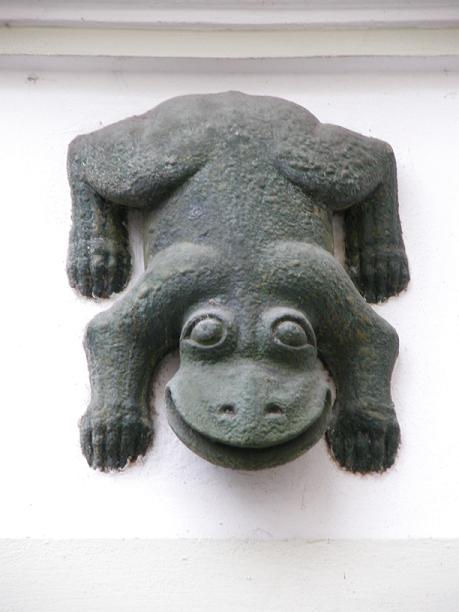 |
In contrast the ground floor was a Hard Rock Cafe albeit without the cafe. It only had the memoriabillia store open which of course we had to have a look around. My father and I have this recipricol arrangement where he buys me HRC badges where ever he goes and I do the same for him. Together we've probably got quite a collection! It was in this square we saw this curious carving of a frog-like creature on a wall. I never did find out what it represented. |
||
Moving on we returned back into the Old Town Square. Along the way this vagrant shuffled over towards us. He looked like he hadn't had a wash since the fall of the Berlin Wall. He held out a shaky dirty nail-bitten hand holding on to a dirty polystyrene cup with some small change in it. I reached into my pocket and pulled out a 50 crown coin and dropped it in his collection tray. His eyes almost popped out of his head as he couldn't believe that I had just given him almost £2. I momentarily thought "Shit, how much was that?" but it was too late to reclaim it. He bared his rotten teeth in what was a frightening smile and trundled off a happy tramp. At least I felt a little better that I had made someone's day. |
Back in the main square we gravitated to the centre where there was a huge monument to a Czech national hero who symbolised struggle against opression. He went by the name of Jan Hus, a 15th century Catholic priest whose own struggle ended when he was burnt at the stake as a heretic. He rebelled againt the catholic church in what was the forerunner of the protestant movement which Martin Luther galvanised a hundred years later. The anniversary of his death is a public holiday in the Czech Republic such is the high regard they have for him. |
||
I don't think his popularity was only a result of his own acheivements but also the legacy he left behind. After his death his followers, known as Hussies, sorry I meant Hussites, began a revolt declaring war against the catholic rulers of Bohemia. His spirirt was revived during the 18th centry revolt against the Austrian-Hungarian occupation and again during the communist rule he was a source of inspiration and hope. Dominating the skyline of not only the square but of the entire city was the Church of Our Lady before Tyn. A peculiar name for a very unique church. Those gothic spires are probably Prague's most recognisable landmark. |
||
It was closely connected with the Hussite movement as it became the principle church of the Reformed Church of Bohemia. I've often wondered why the term Bohemian meant more than just "someone from Bohemia". To be Bohemian is to be unconventional, artisitc and free spirited. Romanticised images of flamboyant writers and musicians spring to mind. A life lived with sense of adventure. It's a trait that I find quite attractive and one I naturally aspire to. The boho hobo. |
||
| Julie braved her backside on a frozen bench at the base of the memorial as I shuffled around the square taking countless more photographs. The other church on the square was the Church of St. Nicholas. In comparisson to the spikey towers of Our Lady before Tyn it looked quite tame. Although the statues on a ledge high above the entrance were interesting. We left the square along Parizska. I don't know if the street name was associating itself with the French capital but it certainly had the feel of a Parisian avenue lined with all the exclusive designers. |
Next on the tourist trail was to cross the Vltava river over the famous Charles Bridge. |
We had no idea what it represented although with Hindi, Arabic, Chinese and Russina script mixed with our familiar alphabet we guessed the artist's message was one of world peace and unity. |
With only half the available space it not surprisingly became congested. Some parts were so narrow and overcrowded that we couldn't stop to take any photographs. We just had to go with the flow. |
Things got a bit better towards the second half and we managed to step away from the tide and begin to appreciate the who's who of Bohemian saints that lined the entire length of the bridge. Darkened by polution they appeared quite ancient and intimidating. There has been a stone bridge crossing here since the 12th century. The original was called Judith Bridge but it collapsed during floods. The Charles Bridge has existed for over six hundred years but the first statue wasn't added until the late 17th century. |
||
The delightful Mala Strana district was even older than the Old Town. Our thoughts turn to lunch and we spotted a cafe called the Bohemia Bagel. I took off my bear-skin like jumper and sat down to peruse the menu whilst Julie went downstairs into the cellar to find the toilets. A few minutes had past when we all heared loud banging noise, a persistent thud, thud, thud. I turned to look at the young waiter behind the counter. He looked back with an alarmed expression. The noise stopped briefly. I turned around to see that everyone in the cafe had stopped eating and were trying to work out from where the noise was coming. |
It then restarted again, this time louder and more frantic as if someone was trying to knock down a wall. It turned out to be someone trying to break down a door! A red-faced Julie walked back into the room having had yet another embarassing toilet trauma. She had locked herself in the toilet but then couldn't unlock it. She was banging hard to get someone's attention and was on the verge of shouting "Help!" when a waitress realised what had happened and unlocked it from the outside. We left as soon as we possibly could after sharing a cream cheese and "shredded vegetables" on a bagel . |
||
There wasn't much of artistic merit left on the wall, everything had been completely saturated with graffitti messages. One twat had violated Lennon's face but in many ways that's exactly its purpose. |
Moving on we continued down hill slightly towards an islet in the Vltava river called Kampa. We crossed over onto Kampa across a small bridge at which point we saw this huge wooden water wheel of the Grand Priory Mill. The narrow piece of water it rested in was called Certovka aka The Devil's Stream but there was no turning today, the spokes had all frozen up. With our Time Out guide in hand we were in search of some Potato and Thyme soup. They promised us a pub-restaurant called U Karlova Mostu and that they served the most delicious soup with topinka, toasted bread rubbed with raw garlic. |
||
This was the main street that lead up to Prague Castle and it became increasingly steep. The view looking back down the hill of the colourful houses and the dome of the Church of St. Nicholas was exceptionally picturesque. It was straight out of a storybook. Adding to the street's fairy tale ambience were the strange and wonderfully descriptive names of the houses such as the house At the Green Lobster, At the Three Fiddles, At the Golden Horseshoe. Even the churches had wonderfully wacky names. One on Nerudova was called the Chruch of Our Lady of Unceasing Succour! |
Another saint showed us the way up towards Prague Castle alongside the Schwarzenberg Palace with its three dimensional painted facade. |
||
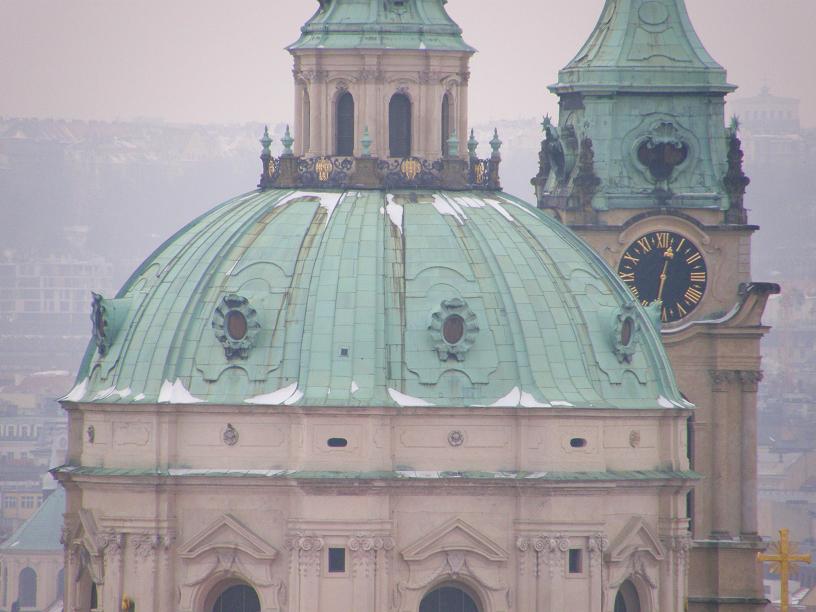 |
With each step we gradually rose above the roof tops and were rewarded with fantastic views across the city. When we reached the top we didn't move for quite some time. |
|
We weren't just taking advantage of standing on level ground for the first time in almost half an hour of contstant uphill marching but we were also captivated by the view. |
From this vantage point we couldn't quite see the river nor Charles Bridge but through the wintry haze we could see most of the city's other landmarks. The cityscape was saturated with the domes and steeples of churches and the pinnacles of many towers. We could easily see why Prague is often referred to as the city of a hundred spires. |
||
|
In fact it was 1929 exactly a thousand years after the assasination of the good king, St. Wenceslas. |
The frescoes, an ornate golden steeple and the gem encrusted tomb of St. Wenceslas himself were quite special. |
| We couldn't stand still for too long without shivering in the cold air. As strange as it seems it was actually colder inside the cathedral than it was outside. We blew out clouds of condensing moisture every time we spoke. The stones must have absorbed the coldness overnight and was behaving like an iced cool box. Back in the relative warmth outside in the large inner courtyard we could now step far enough away from the cathedral to see it in all its glory. On this its southern side we could see the dramatically titled Golden Portal, the original 14th century entrance. |
||
A little further along, standing in the Jirska Namesti square behind the cathedral, we both agreed that St. Vitus had a rather attractive back side with what they called a flying butress design. Wrapping the cathedral snugly were a layer of palatial buildings. Most didn't appear to be open to the public but it was possible to go inside the main Royal Palace Kralovsky Palac. We chose instead to continue with our stroll. "I'm not in the mood for it" I said. |
We stopped at a viewing platform immediately outside the castle walls which gave us another captivating yet different viewpoint of the city.. |
"It's really spooky" said Julie "it's giving me the heebeegeebees!" It certainly captured that ominous vibe of a stalagmite dripping wall of a limestone cave. |
I must have look hilarious as Julie almost fell over with laughter when it happened! |
Eventually we safely reached the banks of the river. It was very quiet around this area. There was hardly anyone else down here. There were a few bars open but we carried on towards Charles Bridge. With our Time Out guide book in hand we found Sport Bar Satlava just off Mostecka a stone's throw away from the end of Charles Bridge. It was a tiny little bar with the tv images projected onto a huge screen that covered one wall. We sat down to watch some ski action and had our first Czech beer of Urquelle Pilsner. |
||
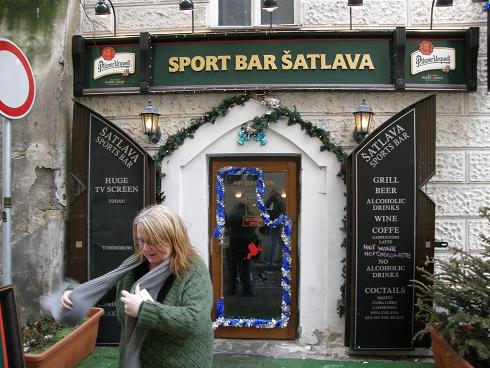 |
They must have got their pricing wrong as my large beer and Julie's small beer were charged at the same price of 30Kc. Thumbing through the pages to shortlist somewhere for lunch Julie pointed out one she liked. "I don't know why it's caught my attention but this one sounds good." I read its descrption. "It'll be the "heaps of mashed potatoes" that's why!" I commented. I then suggested another place called Cowboys. Julie read the details and said "It'll be the "scantily dressed ladies" that's why!". Touche! as they say. |
|
| As
it happened the mash potato restaurant was literally around the corner so
it was an easy decision to make. The near unpronouncable Cukrkavalimonada was in the small square by the Maltese Church of Our Lady Beneath the Chain. |
|
||
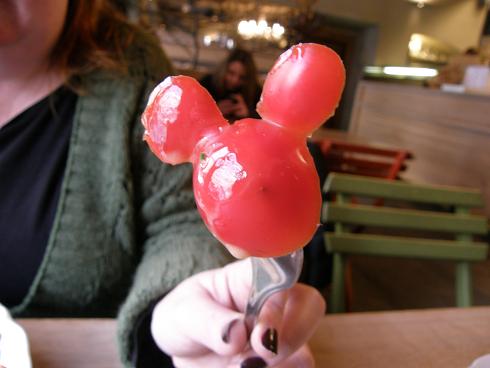 |
It was a good choice. I really enjoyed my savoury mushroom pancake whilst Julie went for the Chicken. "I'm really looking forward to my mash" she said. "Did it say what it was served with?" I asked. |
||
This horrible realisation dawned on her that whilst the Time Out guide said they had the Chicken with heaps of mash we didn't actually see that description on the menu. She said a little prayer "God I hope it comes with mash" but it arrived without any form of potato on the plate. Her motto of "A meal's not a meal without potato" was recited. It was a crime against her palate. Fortunately the Mickey Mouse shaped red pepper that came with the side salad softened the blow. That and the fact that the chicken was very tasty. |
| Our plan for the remainder of the afternoon was to turn down Liliova street for a mini pub crawl of its numerous bars; ending up in Tesco to buy snacks for this evening without getting arrested for being drunk & disorderly. |
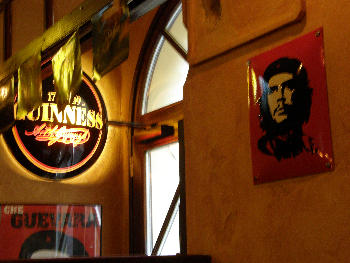 |
The first bar we came across was O'Che's, a Cuban twist on the Irish theme. We were a little disappointed that the only Cuban in the room was the Che Guevara posters on the wall. They didn't even serve the quintessential cocktails such as Mojitos or Daquiri although we could have had Sex On The Beach if we fancied it. At least the Irish theme was more in evidence, perfect for satisying Julie's potato craving. So we sat down with our beers and a bowl of chips to share. They were so nice we had to order another bowl. |
|
The bar also had a large screen that was scheduled to show English Premier League football. It was unfortunately going to be a Manchester Shity game on the big screen but on the small television sets dotted around they were going to show the Manchester United. Beer, Chips and United on the telly, a real home from home. (Actually beer, pizza and United on the telly would have been an even better home from home.) Just as we finished eating Julie's phone rang. It wasn't a number we recognised but she answered. It was rather noisy inside so she popped out. A few minutes later she returned with a shocked and confused look on her face. "That was someone from stay-prague.com" she said. "What did they want?" I asked joining the confused.com club. "They asked me, quite bluntly, "Why did you pull the washing machine out?" " "What"?" I was getting even more confused. |
Julie continued "They said "Why did you pull the washing machine out? You have flooded the apartment!" so I answered them back saying " Pull the washing machine out? I wouldn't be that stupid!" " In the end they reluctantly accepted that Julie nor I were not guilty of premeditated flooding, nor did we conspire to sabotaged the washing machine with the intention of flooding. (Actually is there a name for a compulsive flooder? Like an arsonist is to fire what would it be to water?) It turns out that one of the neighbours had phoned stay-prague.com complaining that water was dripping down through their ceiling. So it was quite serious! "We should go and have a look" suggested Julie. With only ten minutes to go before kick-off I decided to run back to the apartment. I even ran up the five floors. When I opened the door I was expecting a disaster zone but everything had been mopped up and put back in its place. |
||
The wooden kitchen floor did show signs of dampness and there was a nasty scratch where the washing machine must have shook itself free from the kitchen cupboard, falling onto the floor and releasing itself from the waste pipe. That must have been a lot of water! Before leaving I quickly checked the Czech TV and found that the United game was showing on Channel 3. |
 |
So it was a quick change of plans. The mini pub-crawl was cancelled as we decided to return back to the comfort (and much larger TV) of our appartment during the half time break. I had a few more beers at O'Che's whilst watching quite a tense first half. With the score at 0-0 when the half time whistle blew we left the Irish-Cuban bar and meandered our way back towards the Old Town square. We had about fifteen minutes to make it back in time for the second half. Having reached the square inside five minutes we had plenty of time to stop at a stall selling potato cakes. The pattie made with shredded potato was incredibly greasy but most delicious. We shared one but wished we had one each they were no nice. I was a bit concerned about their vegetarian credentials though. Anyway, back in the appartment we sat down on our comfortable sofa to watch the second half. |
After celebrating a narrow victory thanks to a last minutes goal from Bulgarian striker Dimitar Berbetov we decided to have a siesta. All this drinking in the afternoon had made us very very tired. A couple of hours later we woke up still as tired as we felt earlier. Neither one of us felt remotely like going out for the evening so we agreed to survive on the toasted moreish moorish bread with cream cheese for our supper and an early night. We were in Prague, party central on a Saturday night and we were both fast asleep by 9:30pm! Tomorrow night we promised would be different. |
| Next day >>> | ||
|
ęCopyright 2000 - 2020 |